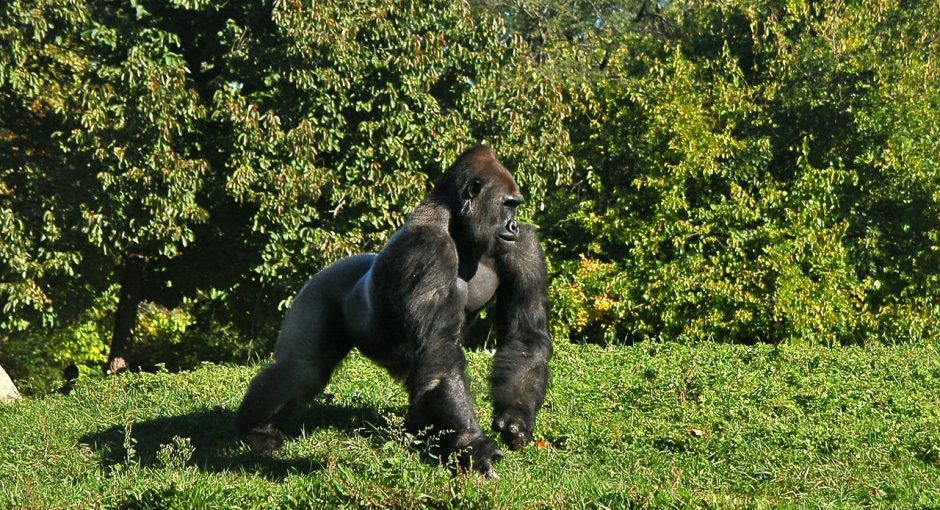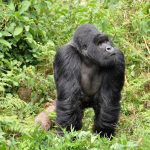THE BEST PLACES TO GO GORILLA TREKKING IN AFRICA
Gorillas share approximately 98% of the human’s DNA making them the closest human’s living relatives in the wild, Gorillas are the largest living primates in the world. Gorillas stay in troops with social structures, behavior like humans as recognize from interacting with their families. all African gorillas belong to the endangered species. Pushed by the extinction due to destruction, prone to diseases, and poaching seeing them in their natural environment is a privilege that some future generations may not have.
Best Places to See Mountain Gorillas in Africa
- Uganda
Uganda has two national parks where gorilla trekking can take place. Uganda’s first & most famous mountain gorilla destination is Bwindi impenetrable forest national park that is recognized by UNESCO, Bwindi covers approximately 321 square kilometers of dense old forest, mist-filled tropical rainforest, Bwindi protects nearly half of the total world’s endangered gorilla population that includes the 10 habituated gorilla troops that are ready to be encountered.
Recommended Tour: 3-Days Uganda Gorilla trekking tours Bwindi via Entebbe.
Uganda’s second national park offering mountain gorilla trekking with less congestion is Mgahinga gorilla national park situated in the extreme corner of southwest Uganda within the slopes of the Virunga chained Mountains. Mgahinga shares its border with Rwanda and the Democratic Republic of Congo.
Recommended Tour: 4-Days Rwanda gorilla trekking tours & golden monkeys in Mgahinga gorilla national park
- Rwanda
Rwandan travelers can trek mountain gorillas at Volcanoes national park situated in the northwest part of Rwanda, Volcanoes national park extends up to the Virunga chained Mountains, which is famous because of the place where the late gorilla scientist Dian Fossey worked and died from.
Different Types of Gorillas
The whole has only two species of gorilla that are the eastern gorillas and the western gorillas. These two species of Gorillas are split into subspecies with the western lowland gorillas being the most common and the eastern lowland gorilla and the mountain gorillas.
The worlds’ western lowland gorillas are quite smaller, numerous and the most widespread gorilla subspecies. These gorillas live in the swamps of central Africa and in the lowland forests that include Cameroon, The Democratic Republic of Congo, Gabon, and the Central African Republic. There are about 100,000 western lowland gorillas remaining in the wild.
The Grauer’s gorillas are the largest gorilla subspecies left that are only viewed in the Democratic Republic of Congo. Although there are estimated to be less than 4,000 left in the mountainous forests in the eastern part of Congo.
There are lesser mountain gorillas left in the world assumed to be around 1,000 individuals scattered into two separate locations. Some mountain gorillas are located within the Virunga chained Mountains that can be accessed from Rwanda at Volcanoes national park, Uganda at Bwindi impenetrable forest national park/Mgahinga gorilla national or the DRC at Virunga national park.
What to Expect as you go Gorilla trekking in Africa
Wherever travelers choose to go gorilla trekking in Africa, it’s important to note that you have to explore the troops on foot, and sighting gorillas are exceptional and guaranteed.
Although all gorilla species always try to stay far from human presence as possible, and the journey to find mountain gorillas involves hiking in the dense forest for hours while searching for Gorilla troops.
Habituated gorilla troops are used to human presence, once you have seen them you are allowed to spend an hour with these incredible apes, this encounter is worth your money.
Rules & Regulations as you go gorilla trekking in Africa
Gorillas are so vulnerable and prone to diseases, human interactions with gorillas are regulated to ensure the safety of both gorillas and the trekkers. Everyone who needs to trek gorillas requires a gorilla trekking permit (your local tour operator should organize this for your gorilla safari) expect your gorilla permit to cost from $400 in the DRC, $1,500 for gorilla in Rwanda, and the normal gorilla trekking in Uganda cost $700, and $1,500 for Gorilla Habituation.
Only a limited number of gorilla permits are issued daily for each location, it’s a good idea to book prior to your travel dates. Gorilla trekking Regulations differ slightly from each country. Generally, these are some of the resembling guidelines from the Rwanda Development Board:
- To minimize the possible spread of human diseases, visitors who are sick with flu, cold, or other contagious diseases are not allowed to visit the gorillas.
- Viewing gorilla time is limited to an hour per habituated family.
- Maximum of 8 visitors tracks a gorilla group which means only 8 trekking permits are issued per group.
- Spitting yourselves in the park is strictly not allowed.
- Should you need to cough, remember to cover your mouth and turn away from the gorillas that you are tracking.
- When you see gorillas, keep your voices low.
- Try as possible to avoid making rapid movements that may frighten the gorilla families.
- If a gorilla vocalizes at you, do not shout, stand still, look away from the gorillas and follow what your guide tells you to do.
- Do not litter in the park.
- Do not use flash photography cameras.
- Tracking gorillas are done by persons who are at the age of 16 years and above.
Image by PublicDomainPictures from Pixabay



